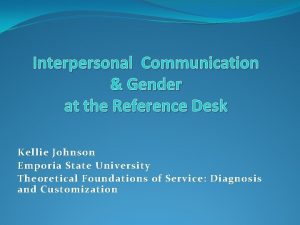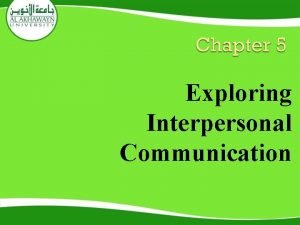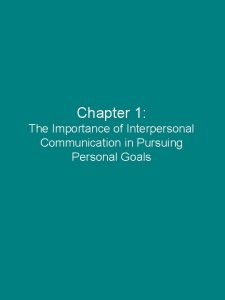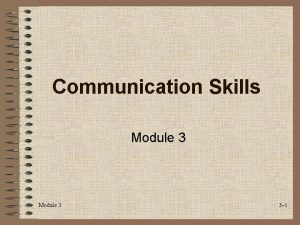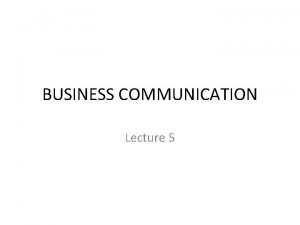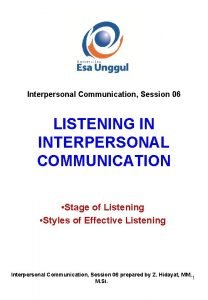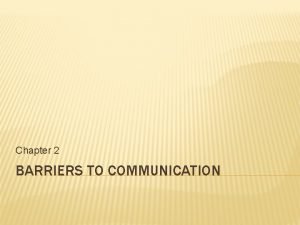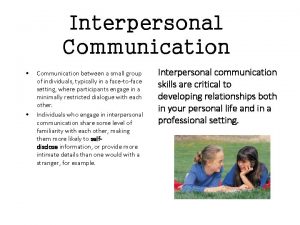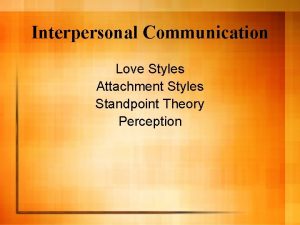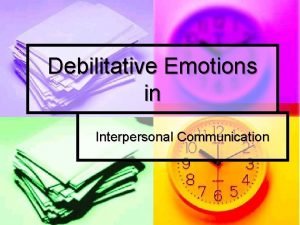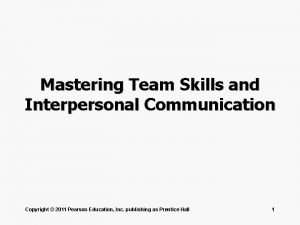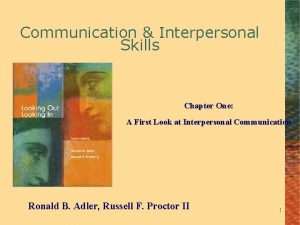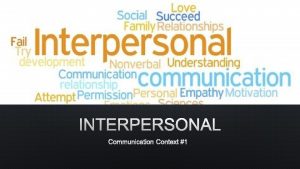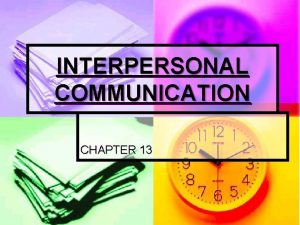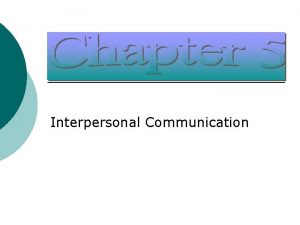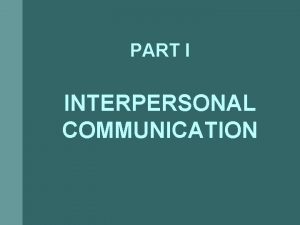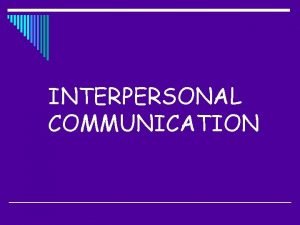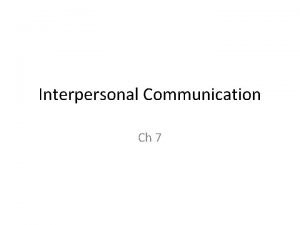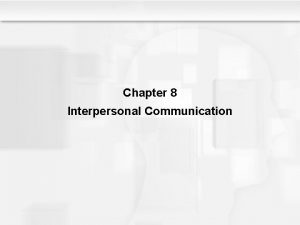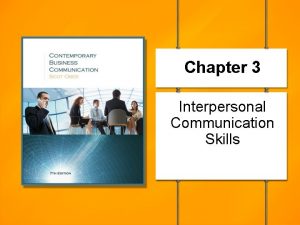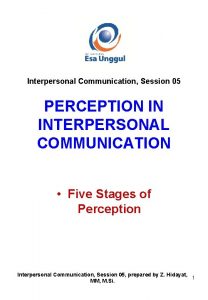8 Emotion 1 Emotion In Interpersonal Communication 2



















- Slides: 19

8 - Emotion 1 Emotion In Interpersonal Communication 2. The Nature Of Emotion 3. Influences On Emotional Experience And Expression 4. Sharpening Your Emotional Communication Skills

Emotion & Mood � Emotion- The body’s multidimensional response to any event that enhances or inhibits one’s goals. ◦ Short-lived � Mood- A feeling, often prolonged, that has no identifiable cause ◦ Persistent ◦ Lasting for days or weeks at a time

Joyful/ Affectionate Emotions -prompt us to feel connected � Happiness cheer) (state of contentment, joy, pleasure, and ◦ A social experience ◦ Contributes positively to our health � Love (caring for, feeling attached to, and feeling deeply committed) and Passion (mixing feeling of joy and surprise with experiences of excitement and attraction) ◦ Passion is enhanced by novelty ◦ Arise out of social interactions � Liking (a product of your overall evaluation of another person) ◦ Display high immediacy behaviors ◦ and shared activities

Hostile Emotions -Destructive emotions prompt us to attack � Anger (perceiving you have been wronged) ◦ Harmful to health ◦ Anger can be self-directed � Contempt else) (feeling you’re better than someone ◦ One of the most harmful emotions ◦ Sends messages of judgment, disapproval, and disrespect � Disgust (feeling of revulsion you experience) ◦ Strong emotional and physical reaction � Jealousy (feeling the existence or the quality of the relationship is threatened by a third party � Envy (wanting what another person has) ◦ Can be positive or negative

Sad and Anxious Emotions -prompt us to withdraw � Sadness (a normal feeling of unhappiness, sorrow, and discouragement due to loss) and Depression (a physical illness lasting for months or years) � Grief (the emotional process of dealing with profound loss) ◦ 5 Steps: denial, anger, bargaining, depression, and acceptance � Fear (mind and body’s reaction to perceived danger) � Social Anxiety (fear of not making a good impression on others ◦ Social Anxiety Disorder

Nature: Multidimensional � Physiological ◦ Patterned, predictable ways your body reacts to emotions ◦ Bodily changes serve a purpose (dealing with the emotion and restoring the body) �Heart rate, breathing rate, pupil dilation, stress hormones, blood sugar, digestive and reproductive systems � Cognitive ◦ Your mind uses your physical feelings and behaviors to identify the emotion

Nature: Multidimensional � Behavioral ◦ “Action Tendencies”motives toward specific behavioral responses to emotions �Fear- Fight or Flight � Social and Cultural ◦ Emotions are shaped by Societies beliefs about the situation �Eating animals (dogs, cats, snails, snakes, camels, guinea pigs, or rates are all common around the world) �Shame and Suicide (High suicide rates in Japan)

Nature: Vary in Valence & Intensity � � Whether emotion is positive or negative Coincide with physical processes ◦ Positive: relaxation, reduced stress, production of hormones (oxytocin and dopamine) ◦ Negative: anxiety, increased blood pressure, elevates stress hormones (cortisol) � Some emotions are have neutral valence (the focus of the Surprise) Valance � Strength of emotion � Fear- Anxiety- Worry. Terror � Debilitating emotions impair our ability to function � Inhibit ability to communicate � Doesn’t last long � Ask for help and support Intensity

Nature: Primary & Secondary Forms � Distinct emotional experiences � People experience and express them the same across cultures � Innate and affected by biology � Joy, sadness, anger, fear, surprise, and disgust � Produces by combining primary emotions � Jealousy (combination of anger, fear, and sadness) � Remorse (sadness and disgust) � Contempt (disgust and anger) � Awe (surprise and fear) Primary Secondary

Nature: Meta-Emotions � Feeling one emotion about another emotion (joy about controlled fear experienced from a scary movie or roller coaster) � Includes how we feel about others emotions too (surprised by another’s anger) � Helps us to understand our own emotions better

Influences on Experience & Expression Cultural Background Display Rules Technology Emotional Contagion Sex and Gender Personality Emotional Intelligence

� Individualist/ Collectivist � Geography � Co-Cultures ◦ Cultural practices shape expression of emotion ◦ India and Japan discourage negative emotion directed at own culture but not outside groups ◦ US and Canada opposite ◦ Chinese Americans express moderation and control ◦ Americans of European descent are more expressive ◦ Mexican Americans tend to be more expressive than Americans of European descent ◦ 1748 Study to Today, warmer climate=more expressive/ colder climate=less expressive ◦ South=more contact/ North=less contact ◦ Hypothesis: Warm weather cause skin to relax and more nerve sensitivity and more attentive to sensations leading to more expression ◦ Encouragement to examine emotions and use emotions in artistic cocultures ◦ Discouragement because of stigma in other co-cultures (military, Scientology) Culture

�Intensification- Exaggerating �De-Intensification- Downplaying �Simulation- Pretending �Inhibition- Acting indifferent when you experience emotion �Masking- Expressing one emotion when you are experiencing another one Display Rules -Unwritten codes that govern the ways people manage and express emotions

�Inhibit Nonverbal Communication �Increases Opportunities for Sharing �Provides Multiple Opportunities for Discussion �Increases Emotional Sharing and Bonding Technology

�Tendency to mimic the emotional experiences and expressions of others �Emotions are “socially contagious” Emotional Contagion

� Sexual Difference In Jealousy ◦ Men experience more sexual jealousy ◦ Women more emotional jealousy ◦ Men respond in confrontational behavior, sexual aggressiveness, promiscuity, and wooing, or breakup ◦ Women respond with self-improvement behaviors, support, demand for commitment, or role reversal ◦ Both respond negatively to the actual experience of infidelity � Gender Roles and Emotional Expression ◦ Androgynous people are more expressive ◦ Traditional gender roles may encourage differentiation in emotional expression ◦ Masculine women and feminine men reported more positive emotions Sex and Gender

�Agreeableness- how pleasant, accommodating, and cooperative you are ◦ Happier and better at managing stress ◦ More constructive ◦ Focus on preserving the relationship �Extroversion- you are how sociable or outgoing ◦ Happier and more positive �Neuroticism- tendency to think negative thoughts about oneself ◦ Focus on negative events ◦ More negative emotions ◦ Manage emotions less successfully Personality

� The ability to perceive and understand emotions � Use emotions to facilitate thought � Manage emotions constructively � Aware of your own emotions and others � More likely to express warmth, affection, and positive emotions *Alexithymia- a personality trait characterized by a relative inability to understand, process, and describe emotions (5 -9% pop. ) Emotional Intelligence

Sharpening Emotional Skills � Identify Emotions ◦ Helps manage emotions productively ◦ Listen to your body, pay attention to your thoughts, and take stock of the situation � Reappraise Negative Emotions ◦ Changes the way you think to reduce emotional effect ◦ Reduces negative emotions ◦ Reframing (pg. 271 - Got Skills) � Accept Responsibility ◦ Own your thoughts and feelings (I-statements) � Separate Emotion from Action ◦ Own your behaviors ◦ Do not act on every emotion ◦ Weigh pros and cons
 Different types of mass communication
Different types of mass communication Interpersonal skills for social workers
Interpersonal skills for social workers Gender interpersonal communication
Gender interpersonal communication Interpersonal communication self concept
Interpersonal communication self concept Exploring interpersonal communication
Exploring interpersonal communication Intrapersonal vs interpersonal
Intrapersonal vs interpersonal Instrumental goals interpersonal communication
Instrumental goals interpersonal communication Module 3 communication/interpersonal skills
Module 3 communication/interpersonal skills Strategies for successful interpersonal communication
Strategies for successful interpersonal communication Listening styles interpersonal communication
Listening styles interpersonal communication Attitude barriers to communication
Attitude barriers to communication Skills for job application
Skills for job application Interpersonal communication vocabulary
Interpersonal communication vocabulary Interpersonal skills in business communication
Interpersonal skills in business communication Interpersonal communication examples
Interpersonal communication examples Standpoint theory
Standpoint theory Debilitative emotions
Debilitative emotions Mastering team skills and interpersonal communication
Mastering team skills and interpersonal communication Universal of interpersonal communication
Universal of interpersonal communication Qualitatively interpersonal communication
Qualitatively interpersonal communication


